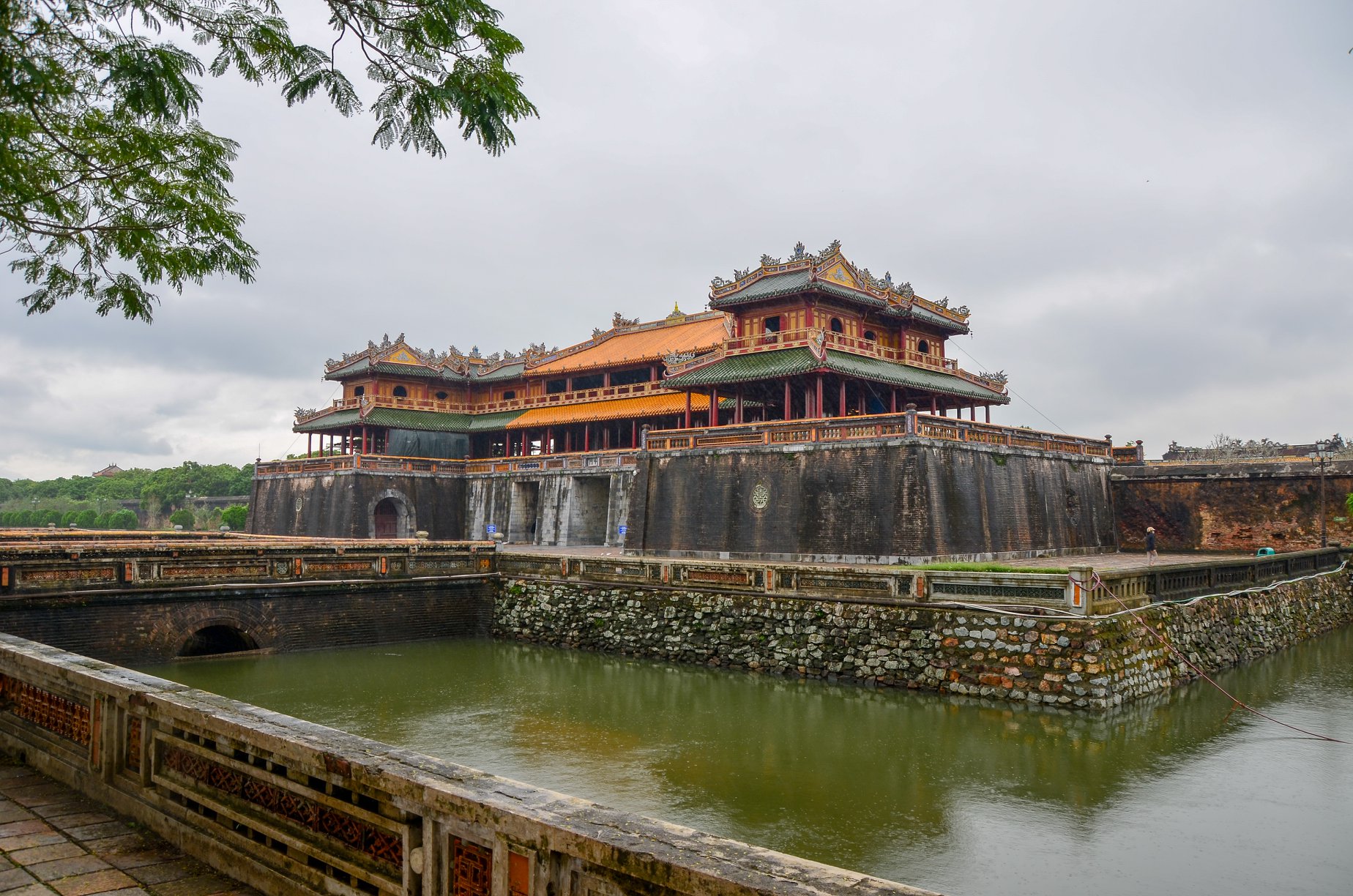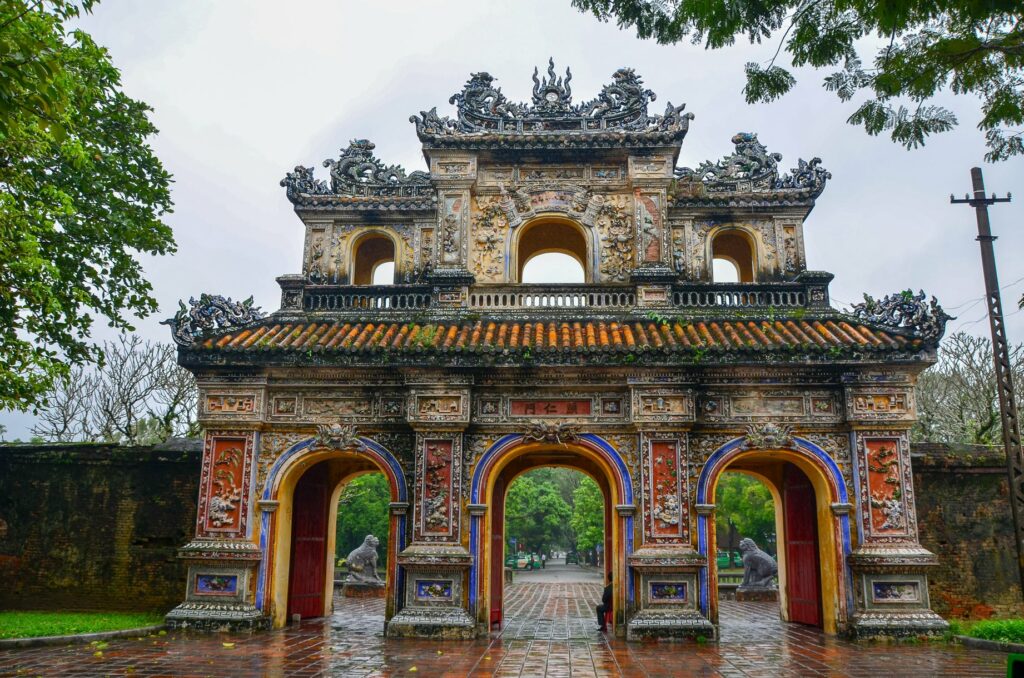Huế is a fascinating city rich in culture, history, and stunning architecture that is tucked away along the Perfume River in central Vietnam. Huế, the former imperial capital of the Nguyen Dynasty, is recognized as a UNESCO World Heritage site due to its abundance of historical treasures.
Huế’s main attraction is the massive Imperial City, a fortress with high walls and a moat for protection. Explore the Forbidden Purple City, which was originally only open to the emperor and his concubines, inside its walls. The complex architectural design embodies both imperial grandeur and traditional Vietnamese aesthetics.
The Perfume River enhances the allure of the city beyond the Imperial City. A tranquil viewpoint of Huế’s landscapes can be had from boat rides along the river, which pass by the famous Thien Mu Pagoda, a seven-story pagoda situated on the riverbank.
The food scene in Huế is equally alluring with its unique specialties and flavors. Savor regional specialties like the fiery beef noodle soup, bún bò Huế, and take in the lively street food scene.
Huế is a must-visit location for anyone looking for architectural wonders and a fascinating look into Vietnam’s imperial past because of its rich heritage, which includes its stunning riverfront and historic citadel. In this article, we will give you what you should do and see when you visit Huế in Vietnam.
Visit the Imperial City in Huế
Travelling to the Imperial City of Huế is like taking a trip back in time to when Vietnam was a kingdom. Tucked away beside the Perfume River, this UNESCO World Heritage Site—which was once the seat of the Nguyen Dynasty—is a monument to the nation’s imperial past.
The Imperial City is a marvel of architecture, surrounded by high walls and a moat for safety. The Forbidden Purple City, formerly the exclusive domain of the emperor and his closest allies, is located inside its boundaries. The elaborate architecture of the pavilions, gates, and palaces displays the imperial grandeur and traditional Vietnamese craftsmanship.
The Imperial City’s regal halls, tranquil gardens, and age-old gates all contribute to its rich historical tapestry. Highlights that take guests back in time include the Thai Hoa Palace, the Noon Gate, and the Hall of Mandarins.
Offering insights into Vietnamese court life, customs, and governance, The Imperial City is a cultural treasure trove. It is a fascinating destination for history buffs and those looking to fully immerse themselves in the grandeur of Vietnam’s imperial legacy because of its magnificent architecture and meticulously preserved artefacts.
Visit the Thien Mu Pagoda in Huế
In Huế, the Thien Mu Pagoda is a famous representation of both architectural grace and spiritual significance. It is perched elegantly on the northern bank of the Perfume River. This seven-story pagoda, also referred to as the “Pagoda of the Celestial Lady,” is a historical landmark with a rich cultural past that is both a religious site and a cultural treasure.
Built in 1601, the Thien Mu Pagoda features an impressive octagonal tower with a different Buddha on each floor. A masterwork of traditional Vietnamese architecture, the pagoda’s tiered structure is embellished with minute details and symbolic imagery.
The antique Austin car that is parked on Thien Mu Pagoda’s property is among its most moving features. A somber reminder of the nation’s turbulent past is this car, driven by Thich Quang Duc, a monk who famously self-immolated in protest against the South Vietnamese government in 1963.
Thien Mu Pagoda is surrounded by verdant gardens and provides a tranquil haven with expansive views of the Perfume River. Both pilgrims and tourists visit the pagoda to take in its architectural splendor, experience its meditative atmosphere, and recognize its significance in Huế and Vietnam’s cultural fabric.
Visit the Royal Tombs in Huế
The magnificent mausoleums known as the Royal Tombs in Huế, Vietnam, honor the emperors of the Nguyen Dynasty, which was Vietnam’s last ruling family. Dispersed throughout the lovely Perfume River, every tomb bears witness to the imperial magnificence and distinct architectural designs of the emperor who occupied each one.
Emperor Minh Mang’s tomb is among the most well-known, and it is distinguished by its tasteful blend with the natural world. The expansive complex surrounding the tomb includes calm lakes, pavilions, and well-kept gardens that showcase the emperor’s aesthetic and philosophical beliefs.
On the other hand, the tomb of Emperor Khai Dinh exhibits a blend of Eastern and Western architectural styles. Its lavish interiors, which deviate from traditional Vietnamese design, are embellished with elaborate details and vibrant mosaics.
The poetic charm of the Tomb of Tu Duc, surrounded by peaceful lakes and pine forests, is what makes it stand out. The emperor’s residence, a temple, and pavilions that reflect Tu Duc’s love of philosophy and literature are all part of this tomb complex.
The Royal Tombs are an important and captivating attraction in Huế because visiting these royal resting places provides not only with an insight into the lives of Vietnam’s rulers but also with an appreciation of the rich cultural and artistic heritage of the nation.
Walk along the Perfume River in Huế
A serene and picturesque walk along the banks of the Perfume River in Huế immerses visitors in the natural beauty and rich cultural legacy of this historic Vietnamese city. The river meanders through verdant landscapes, giving a tranquil backdrop to the city’s landmarks. It gets its name from the fragrant flowers that fall into its waters from orchards upstream.
Beautiful views of the famous Thien Mu Pagoda, with its seven-tiered tower reflected in the placid waters, can be had while strolling along the riverbanks. Elegant bridges, like the Trang Tien Bridge, span the Perfume River, resulting in picture-perfect scenes that perfectly encapsulate Huế.
The walk’s charm is enhanced by the traditional boats that line the riverbanks. Guests can take a leisurely boat ride down the Perfume River with local boatmen, who are frequently dressed in traditional áo dài attire. This provides a distinctive viewpoint of the surrounding vegetation and the skyline of the city.
The Perfume River is illuminated by lantern light as the sun sets, creating a mystical ambiance. Strolling alongside this ancient canal transforms into a sensory experience, blending the architectural attractions of Huế with the calm sounds of the river’s flow and the delicate aromas that gave rise to its name.
Go to the Bach Ma National Park in Huế
Bach Ma National Park is a verdant oasis known for its biodiversity, lush landscapes, and expansive views of the South China Sea. It is tucked away in the Annamite Range in central Vietnam. Covering an area of more than 22,000 hectares, the park is a sanctuary for both adventure seekers and lovers of the natural world.
The diverse ecosystems found in Bach Ma National Park, which include evergreen, subtropical, and tropical rainforests, are what make the park unique. The park is a hotspot for biodiversity in the area because of its rich flora and fauna, which includes rare and endangered species. A wide range of wildlife, including langurs, macaques, and bird species, can be seen by visitors.
Standing at 1,450 meters, the summit of Bach Ma Mountain is one of the park’s highlights. Beautiful views of the surrounding mountains, coast, and dense forest canopy can be seen during the ascent. The picturesque Five Lakes Cascade, a collection of tumbling waterfalls and pools that offer a cool haven in the middle of the outdoors, is open to visitors.
Along with historical artefacts, Bach Ma National Park is home to a diverse range of flora and villas from the French colonial era. The park is crisscrossed with hiking trails that let visitors explore its natural beauty and discover the various ecosystems that make Bach Ma an enthralling ecotourism destination in Vietnam.
Try some Street Food in Hue
Vietnam’s historic capital, Hue, is known for its colorful and delectable street food and is a culinary paradise. The street food in the city offers a distinctive culinary experience, showcasing a delightful tapestry of traditional Vietnamese flavors.
“Bun Bo Hue,” a hearty noodle soup with beef, pork, and a flavorful broth enhanced with chilli and lemongrass, is one of Hue’s specialties. This dish perfectly captures the bold and aromatic culinary profile of the area when served with fresh herbs, lime, and chilli.
When strolling through the streets of Hue, you’ll come across “Banh Khoai,” which is a crispy pancake stuffed with pork, prawns and bean sprouts and served with a side of tart dipping sauce. “Banh Loc,” which are translucent dumplings filled with pork or shrimp and made with tapioca starch, are another delicious street food find that highlights the delicate flavors of the area.
Try “Che Hue,” a selection of traditional Vietnamese desserts, for a sweet treat. These vibrant and alluring sweets, which could include puddings, jellies, and sweet soups, provide a delightful end to your culinary journey.
Hue’s street vendors, who set up along busy alleys and historical sites, are an essential part of the city’s culinary scene. This produces a lively atmosphere in which you can indulge in the culinary treasures of the city and appreciate its rich history.
Street food in Hue is an experience, not just a meal. Through its mouth-watering offerings, you can connect with the heart and soul of this ancient Vietnamese city thanks to the immersive experience created by the fragrant scents, vivid colors, and varied flavors that permeate the streets.
Nightlife in Hue
Despite lacking the vibrant nightlife of bigger cities, Hue provides a distinctive and endearing nighttime experience. Hue’s nightlife consists of a mix of local bars, riverfront activities, and cultural performances.
The traditional Vietnamese music and dance performances, which are frequently held at historical locations like the Imperial City, are a highlight of Hue’s nightlife. Known as “Ca Hue” or “Hue Singing,” these performances feature musicians and dancers dressed in traditional clothing, creating an enthralling atmosphere that whisks viewers back to the time of the imperial era.
At night, the Perfume River, which passes through the center of Hue, acquires a mystical aura. A calm and lovely scene is created as the riverbanks come to life with residents and visitors taking pleasure in boat rides decorated with vibrant lanterns. The enchantment is enhanced by the vividly colored illumination of the Trang Tien Bridge.
Hue doesn’t have a big nightlife, but there are a few neighborhood pubs and bars with a relaxed vibe. For tourists looking for a more laid-back evening with a cool drink and maybe some live music, these places are ideal.
After dusk, the local night markets provide an opportunity to explore Vietnamese street food and handicrafts in addition to traditional performances and riverside activities. The smell of regional specialties, the sounds of neighbourhood life, and the lively vitality that characterises Hue’s nightlife can all be experienced while meandering through these markets.
Hue’s unique nocturnal atmosphere is created by a unique blend of cultural experiences, riverside charm, and local watering holes, even though the city’s nightlife may not be as lively as that of some of Vietnam’s larger cities.
Visit the Dong Ba Market in Hue
Located in the center of Hue, the lively and historic Dong Ba Market captures the spirit of the city’s rich cultural and culinary diversity. Dong Ba Market, which dates back to the 19th century, has not only endured but grown to become a well-known gathering place for both residents and visitors.
This vibrant market, which offers a wide selection of fresh produce, spices, textiles, and handicrafts, is a sensory overload. But Dong Ba Market is particularly well-known for its wide assortment of regional specialties and street food. Famous Hue cuisine includes Banh Khoai (stuffed crispy pancake), Banh Beo (steamed rice cakes), and Bun Bo Hue (beef noodle soup).
The market is bustling and noisy, with sellers showing off their goods over the lively noise of haggling and the enticing smells filling the air. Dong Ba Market is an immersive experience that offers insight into the everyday lives of the people of Hue, not just a place to shop.
Dong Ba Market is the perfect place to go if you’re looking for genuine cultural experiences. The market is a must-visit for anyone wishing to experience the tastes and customs of Hue because of its rich history and varied selection. Discover the essence of Vietnamese culture through a multi-sensory experience at Dong Ba Market, regardless of your interests in food, history, or leisure travel.
Visit the Thanh Toan Bridge in Hue
In the Thanh Thuy Village, close to Hue, Vietnam, the picturesque covered bridge known as the Thanh Toan Bridge serves as a quaint reminder of both local history and traditional Vietnamese architecture. Constructed in 1776, the bridge is a magnificent illustration of Japanese influence, exhibiting a distinct fusion of Japanese and Vietnamese design elements.
Known by many as the “Japanese Bridge,” this well-preserved wooden bridge spans the Nhu Y River. It fulfils symbolic and utilitarian roles for the neighbourhood. In addition to serving as a crucial crossing point for villagers, the bridge serves as a social hub where people congregate and strengthen their sense of community.
The intricate architecture of the Thanh Toan Bridge is what makes it unique. The bridge’s exquisitely carved tile roof provides shade and cover for pedestrians crossing the street. There is a small temple within that offers residents a peaceful place to honour their ancestors and offer prayers for good fortune.
In addition, a museum featuring the agricultural implements utilised by nearby farmers as well as the history of the Thanh Toan Bridge is open to visitors. With its traditional homes and verdant surroundings, the neighbourhood provides a tranquil haven from the bustle of everyday life.
The architectural marvel that is Thanh Toan Bridge offers visitors a window into Vietnam’s rich cultural legacy by fusing aesthetics, history, and communal significance into one ageless design.
Festivals in Huế
Vibrant festivals that highlight Vietnamese customs and heritage are held in Huế, a city rich in history and culture. Held every two years, the Huế Festival is one of the most important events. With a wide range of activities, such as processions, historical ceremony re-enactments, and traditional music and dance performances, this grand celebration honors the city’s imperial heritage. Both residents and visitors are drawn to the Huế Festival, which promotes pride in Vietnam’s rich cultural diversity.
Another popular festival in Huế is the Mid-Autumn Festival, also known as Tết Trung Thu. Families get together to celebrate with mooncakes, traditional folk performances, and colorful lanterns. Lanterns are used to decorate the city’s streets, which gives the place a charming and joyous feel.
Huế is also well-known for holding the Buddhist Vesak Festival, which honours the Buddha’s conception, realisation, and demise. The city’s pagodas are crowded with pilgrims, and vibrant processions light up the streets, signifying the occasion’s spiritual significance.
In addition to providing a window into Vietnam’s rich cultural past, these Huế festivals offer visitors and locals alike an engrossing and joyful experience that strengthens their bond with the city’s customs.
11. Do a DMZ Tour in Hue
A tour of the Demilitarized Zone (DMZ) departing from Hue, Vietnam, takes visitors through the historical relics of the Vietnam War and provides a moving look into the complicated past of the nation. During the Vietnam War, the DMZ functioned as a buffer zone separating North and South Vietnam; today, it is a place of historical significance and contemplation.
Usually, the tour includes stops at significant locations that were vital to the outcome of the conflict. The villagers constructed an underground network called the Vinh Moc Tunnels to provide shelter during bombardments, demonstrating their ingenuity and tenacity. By exploring the tunnels, visitors can get a first-hand look at the difficulties that residents of this war-torn area face.
Another noteworthy location is the former U.S. Marine Corps base, Khe Sanh Combat Base. Here, artillery, bunkers, and aircraft from the war serve as a sobering reminder of the toll the fight took on American and Vietnamese forces.
The Ben Hai River and Hien Luong Bridge, which once served as the country’s borders between North and South Vietnam, represent the division brought about by the conflict. Painted in the national flag’s colors, the bridge arouses strong feelings and acts as a moving reminder of Vietnam’s reunification.
Expert guides provide historical anecdotes during the DMZ tour, illuminating the nuances of the conflict and the perspectives of those who experienced it. The trip is a somber but instructive examination of Vietnam’s resiliency, progress, and unwavering hope for peace.

















